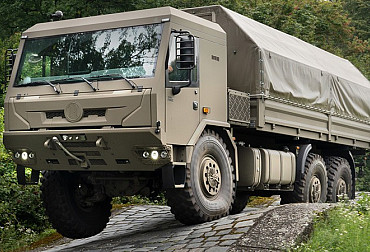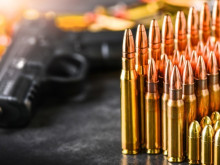CV90 IFV in action on the test range and presentation of the current Swedish defence policy
Recently, our editorial team was invited to Sweden to get acquainted with the CV90 tracked infantry fighting vehicle, which our Ministry of Defence is currently negotiating with the Swedes to buy, both theoretically and practically, over the course of 3 days. We visited the test range of the CV90 manufacturer, BAE Systems, and also had the opportunity to participate in live firing of the CV90 armoured personnel carrier as part of a training exercise for members of the 18th Gotland Regiment. The visit also included a presentation on the evolution of the CV90 combat vehicle, a presentation on how BAE Systems cooperates with Czech defence industry representatives on the CV90 project and we also learned interesting information about the Swedish defence industry, the government agency FMV and the Swedish Security Industry Association SOFF.
Video: Report - CV90 IFV in action on the test range and presentation of current Swedish defence policy / CZ DEFENCE
We spent the first day at the BAE Systems Hägglunds test site located near the village of Norrvästansjö. Here we were presented with different versions of the CV90 vehicle, namely the CV90 version of the IFV which participated in the functional sample tests of the IFV within the framework of the Czech Army’s selection process, the Dutch CV90 MkIII vehicles which were undergoing an upgrade (Mid-Life-Upgrade), the CV90 demonstrator with 120mm gun and the CV90 without turret in the APC (armoured personnel carrier) version. We had the opportunity to drive the latter vehicle and we have to admit that the CV90 has quite easy and precise steering and the chassis provides high comfort when crossing uneven ground thanks to excellent damping.
The test range is used all year round, helped by a heated concrete track. The polygon also has a track with retarders or a 60 percent incline track. Vehicles are tested on concrete, gravel and natural terrain. The test vehicles run circuits within the polygon, with an average of 100 kilometres each. In the future, the base will be expanded to include a shooting range, a special hall (climate chamber) where vehicles will be exposed to various temperature extremes, and plans are in place to build additional administrative buildings.
 Picture: Presentation of different versions and variants of CV90 vehicles at the BAE Systems Hägglunds test range | Michal Pivoňka / CZ DEFENCE
Picture: Presentation of different versions and variants of CV90 vehicles at the BAE Systems Hägglunds test range | Michal Pivoňka / CZ DEFENCE
On the presented Dutch CV90 MkIII vehicle with 35mm cannon it was very interesting to listen to the existing and planned systems of crew protection within the turret modernization, where we were most interested in the laser protection system and 360° camera system, which is capable of assessing the risk of an enemy missile attack up to a distance of 4,000 metres, and if the trajectory of the missile indicates that it could hit the vehicle, defensive grenades are activated on the vehicle to deflect the missile using pressure waves.
The newer versions of the CV90, which are operated by Switzerland and Norway (and will also be used by the Czech Republic), also have composite rubber tracks, which make the vehicle quieter when driving, also save the electronics inside the vehicle due to less vibration, and last but not least, the CV90 is about 700 kilograms lighter than the metal tracks.
 Picture: Dynamic demonstration of the CV90 in action | Michal Pivoňka / CZ DEFENCE
Picture: Dynamic demonstration of the CV90 in action | Michal Pivoňka / CZ DEFENCE
The CV90 is able to cooperate with several types of drones to enhance situational awareness on the battlefield, but the vehicle is also able to fight effectively against hostile drones, which the test centre confirmed to us through a demonstration of the test results, where a single 35mm round from the CV90 cannon was able to eliminate a test drone, the fragments of which we were able to see with our own eyes. There really wasn't much left of it. According to BAE Systems officials, CV90 vehicles are ready to deal with stand-off munitions. The CV90 has a universal sight and fire control system for tanks and combat vehicles called UTAAS (Universal Tank and Anti-Aircraft System). Thanks to this integrated technology, the gunner in the CV90 can aim independently of vehicle movement, while the fire control system automatically aims the barrel, which in practice means it can fire faster than with conventional sighting technology. The CV90 turret can accommodate guns from 30 mm to 50 mm calibre. The new versions of the turret, which will be received by the Czech Republic and Slovakia, among others, will also be able to fire integrated long-range Spike anti-tank guided missiles.
After the basic theoretical presentation of the CV90 vehicles, we then had the opportunity to watch a dynamic demonstration of these armoured vehicles, when the vehicles were travelling at different speeds through the terrain, over iron speed bumps and we also witnessed a situation when a 30-ton crumb was momentarily in the air when it was crossing an artificial bump at high speed. We then took a ride in the drop zone and were given a ride through the terrain. Inside the vehicle there was plenty of room for each passenger, even above the head where at 186 cm height a person (without helmet) still had about 20 cm of free space. It was also possible to talk normally in the vehicle while driving with a raised voice without using a headset with a radio, so we were pleasantly surprised noise-wise. Although the vehicle was travelling over quite difficult terrain, inside we were quite comfortable in the suspension seats and special leg straps and did not fly from side to side. As mentioned in the introduction, we finally had the opportunity to drive the CV90 after a short briefing. Although no more sophisticated conclusions can be drawn from one short circuit, it can certainly be said that the handling and overall behaviour of the vehicle in the field was at least as enjoyable as, for example, a ride in a Leopard 2 A7 tank during our previous visit to Krauss-Maffei Wegmann.
 Picture: BAE Systems Hägglunds centre in Örnsköldsvik | Michal Pivoňka / CZ DEFENCE
Picture: BAE Systems Hägglunds centre in Örnsköldsvik | Michal Pivoňka / CZ DEFENCE
Later, we moved from the test range to the BAE Systems Hägglunds centre in Örnsköldsvik, where the lecture led by Dan Lindell, CV90 programme manager, continued. The presentation on the evolution of the CV90 (Mk0-MkIV) included the interesting fact that the development of subsequent versions of the CV90 has always taken longer than the development of the first Mk0.
 Picture: CV90 Program Manager Dan Lindell gave an interesting lecture on CV90 vehicles | Michal Pivoňka / CZ DEFENCE
Picture: CV90 Program Manager Dan Lindell gave an interesting lecture on CV90 vehicles | Michal Pivoňka / CZ DEFENCE
In the next part of the lecture, Hakån Karlsson, who is responsible for cooperation with the Czech industry, introduced us to the Czech companies that BAE Systems has chosen as its partners, not only for the production of CV90 vehicles, but also for other production of the Swedish company. The strategic partners include VOP CZ, Excalibur Army (CSG), VR Group, Vojenský technický ústav, ČVUT, Meopta and Ray Service. The largest share will be held by VOP CZ (production of the chassis and assembly of the chassis with the turret), Excalibur Army (turret production) and Meopta (cooperation on the UTAAS system).
 Picture: In the next part of the lecture, Hakån Karlsson, who is responsible for cooperation with Czech industry, introduced us to Czech companies that BAE Systems has chosen as partners | Michal Pivoňka / CZ DEFENCE
Picture: In the next part of the lecture, Hakån Karlsson, who is responsible for cooperation with Czech industry, introduced us to Czech companies that BAE Systems has chosen as partners | Michal Pivoňka / CZ DEFENCE
The production of CV90CZ vehicles, as the vehicles produced in the Czech Republic should be called, also envisages the possible production of two special versions of the vehicles, namely the forward artillery observer version and the ambulance. It was also mentioned at the presentation that if the contract for the acquisition of the CV90 MkIV IFV for the Czech Republic is signed, BAE Systems is able to deliver the first units in 18-24 months from the signing of the contract.
On the second day of our visit, we had the opportunity to meet with the Czech Ambassador to the Kingdom of Sweden, Anita Grmelová, who we asked about Sweden's accession to NATO and also asked what the Swedes see as the potential risks associated with a Russian invasion of Ukraine.
Later, we were treated to a presentation by BAE Systems Bofors and its products, where company director Lena Gillström gave us an overview of the history of the company, which was founded in 1646. By the way, the Swedish CV9040 vehicles have their time-tested 40mm cannon from Bofors. BAE Systems Bofors produces naval weapon systems (Bofors 40 Mk4), land-based air defence equipment, large-calibre ammunition (155mm M982 Excalibur, 155mm Bonus Mk2) and last but not least artillery systems (ARCHER 155/52 howitzers).
 Picture: Later we were treated to a presentation by BAE Systems Bofors and its products | Michal Pivoňka / CZ DEFENCE
Picture: Later we were treated to a presentation by BAE Systems Bofors and its products | Michal Pivoňka / CZ DEFENCE
Another presentation led by Joakim Wallin from the government agency FMV covered the vision of Swedish defence after 2022 in terms of massive reinforcement of the army under the Defence Act (valid from 2021-2025), Sweden's accession to NATO, etc. Sweden is well aware of the security risks associated with the events in Ukraine and is therefore trying to increase its military capabilities dramatically. Sweden would like to achieve defence spending of 1.5% of GDP by 2025, with a future vision of increasing spending to 2%. Regarding NATO accession, this proposal, which passed the local parliament on 16 May, had 80% support at the time. In addition to the acquisition of new assets (combat vessels, fighter aircraft, artillery systems, anti-tank missile systems, etc.), Sweden will also focus on modernising its existing equipment in the form of Leopard tanks and CV90 biplanes, as well as focusing on increased recruitment.
We also heard a lecture by Björn Fägersten from the Swedish Foreign Policy Institute, which has changed again after the events in Ukraine. In this context, we asked him some questions about the threats and lessons from the situation in Ukraine, but also about the threats from China and from the African continent.
An interesting lecture was given by Robert Limmergård from the Swedish Security Industry Association SOFF, which brings together 160 members (58 of which are non-Swedish owned). Last year, the members of the association achieved total revenues in the field of "security and defence" of approximately 4.6 billion euros.
 Picture: An interesting presentation by Robert Limmergård from the Swedish Security Industry Association SOFF | Michal Pivoňka / CZ DEFENCE
Picture: An interesting presentation by Robert Limmergård from the Swedish Security Industry Association SOFF | Michal Pivoňka / CZ DEFENCE





















